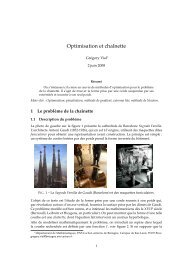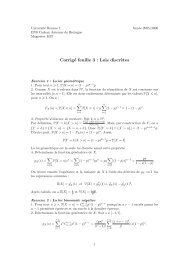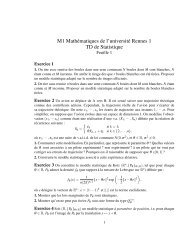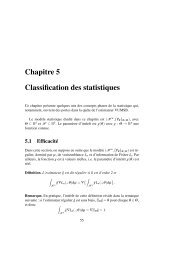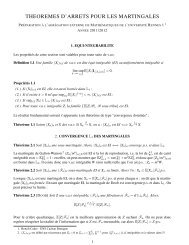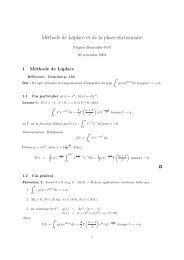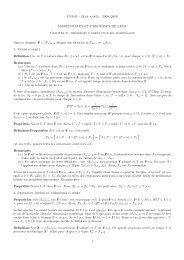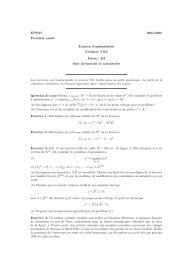best design for a fastest cells selecting process - ENS de Cachan ...
best design for a fastest cells selecting process - ENS de Cachan ...
best design for a fastest cells selecting process - ENS de Cachan ...
- No tags were found...
Create successful ePaper yourself
Turn your PDF publications into a flip-book with our unique Google optimized e-Paper software.
4 MICHEL PIERRE AND GRÉGORY VIALNow, t ∈ [t 0 , τ] → a(t) ∈ [0, |x 0 |] is strictly <strong>de</strong>creasing. We <strong>de</strong>note by a −1 its inverse and we<strong>de</strong>neK ={t ∈ [t 0 , T ]; U ′′ (t) · e 0 ≤ 0}; ∀t ∈ K, χ K (t) = 1, ∀t ∈ [t 0 , T ]\K, χ K (t) = 0, (9)∀r ∈ [0, |x 0 |], g(r) = χ K (a −1 (r)) [ ∇F ( U(a −1 (r)) ) · e 0 ]. (10)If we now set u(t) = a(t)e 0 , we have u(t 0 ) = x 0 and <strong>for</strong> all t ∈ [t 0 , τ]:u ′′ (t) = a ′′ (t)e 0 = −χ K (t)[∇F (U(t)) · e 0 ]e 0 = −g(a(t))e 0 = −g(|u(t)|)e 0 .Note that g ≥ 0 and is continuous (this only needs to be checked on the boundary of K, and it iseasy). We set G(r) = ∫ rg(s)ds and we nish as in (7)(8), checking that, here again:0G(|u(τ)|) = 0, 2G(|x 0 |) = |u ′ (τ)| ≤ |U ′ (τ) · e 0 | ≤ |U ′ (τ)| ≤ 2F (x 0 ).Remark 2. : Case of friction. Assume there is friction in the movement of the <strong>cells</strong> (which isactually always the case). In this situation, instead of (2), the evolution of each cell is given byU ′′ (t) = −∇F (U(t)) + Θ(U ′ (t)),where Θ ∈ C 1 (R N , R N ). Then Theorem 2.1 may be exten<strong>de</strong>d as follows:Theorem 2.2. There exists (t 0 , τ) ∈ [0, T )×(0, T ], G ∈ W 1,∞ [0, |x 0 |], h : [0, +∞) → R measurableand boun<strong>de</strong>d and u ∈ C 2 ([t 0 , τ]; R N ) such that,a.e.t ∈ (t 0 , τ), u ′′ (t) = −G ′ (|u(t)|)e 0 + h(|u ′ (t)|)e 0 , u(t 0 ) = x 0 , u ′ (t 0 ) = 0, (11)G(0) = 0, ‖G ′ ‖ ∞ ≤ ‖∇F ‖ ∞ , ‖h‖ ∞ ≤ ‖Θ‖ ∞ , (12)u(τ) = 0, and ∀ t ∈ [t 0 , τ], |u(t)| ≤ |U(t)|. (13)Proof. We just indicate how to modify the proof of Theorem 2.1. We use the same function a(t)<strong>de</strong>ned through the integration of −[U ′′ (t) · e 0 ] − . The mapping t ∈ [t 0 , τ] → a(t) ∈ [0, |x 0 |] isnonincreasing, where t 0 , τ are <strong>de</strong>ned in the same way as in Theorem 2.1. Again, we <strong>de</strong>note itsinverse by a −1 and we <strong>de</strong>ne K and g as in (9) and (10). Moreover, the mapping t → −a ′ (t) ∈[0, −a ′ (τ)] is non<strong>de</strong>creasing. We <strong>de</strong>note by β its left-continuous inverse and we <strong>de</strong>neIt is then easy to check that∀r ′ ∈ [0, −a ′ (τ)], h(r ′ ) = χ K(β(r ′ ) ) [Θ ( U ′ (β(r ′ )) ) · e 0 ].a ′′ (t) = −g(a(t)) + h(−a ′ (t)), or u ′′ (t) = −g(|u(t)|)e 0 + h(|u ′ (t)|)e 0 .Remark 3. : Note that u ′′ remains continuous, but h may be discontinuous. Actually, if it is thecase, then τ < T . Nevertheless, we may approximate h (and also g) by more regular functions andthe associated solutions still reach the origin in time τ + ɛ < T .2.2. Best potential <strong>for</strong> a single cell. One may ask whether it is still possible to improve theradial potential G in such a way that the corresponding solution reaches the origin even faster.Let us analyze this in the case without friction. Then, it turns out that an easy expression canbe obtained <strong>for</strong> the reaching time. Let us write the solution as follows, where a(t) is a scalarfunction and G ∈ C 2 (R, R):a ′′ (t) = − 1 2 G′ (a(t)), a(0) = a 0 > 0, a ′ (0) = 0.(We ad<strong>de</strong>d a factor 1/2 in the notation only to simplify further expressions). Since we want toaccelerate the particle towards a(·) = 0, it is better to assume that G ′ ≥ 0 (as it is the case in theG obtained in Theorem 2.1 above). This may be integrated asa ′2 (t) = G(a 0 ) − G(a(t)) or− a ′ (t) = √ G(a 0 ) − G(a(t)).




